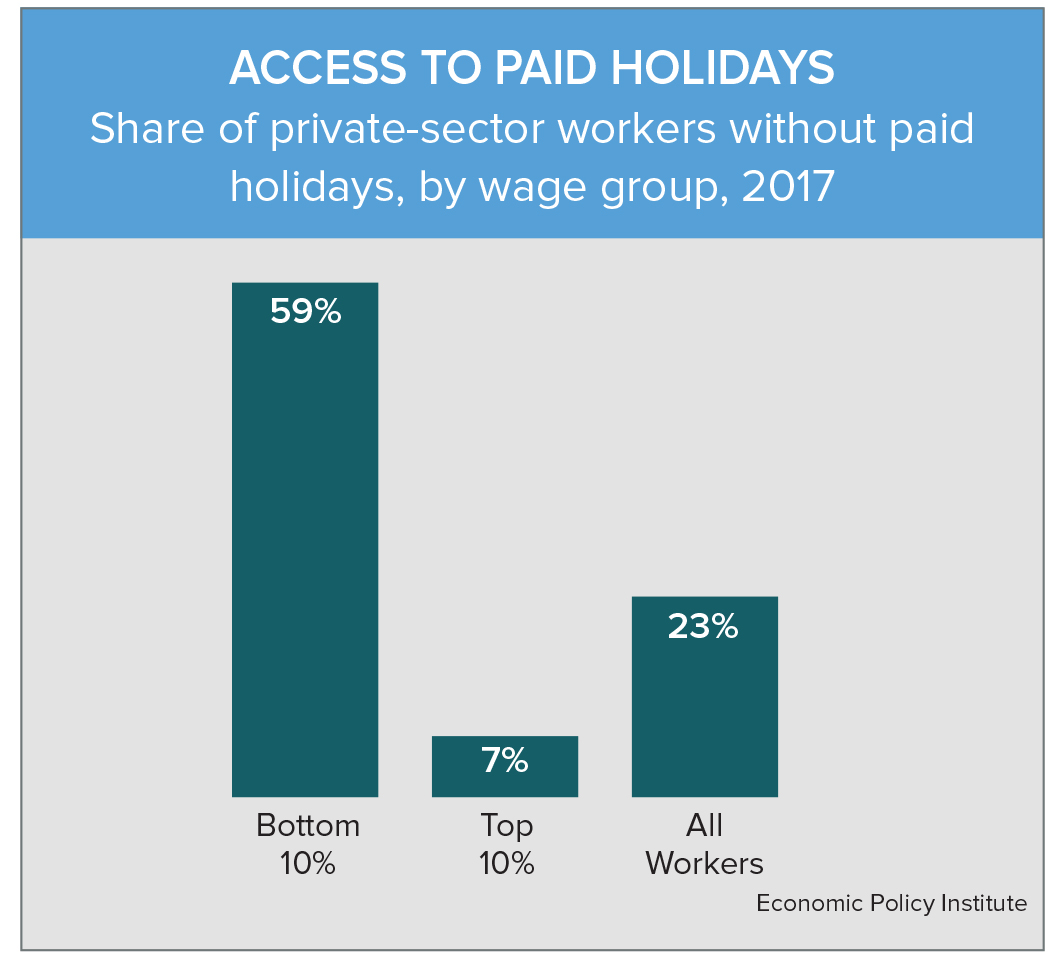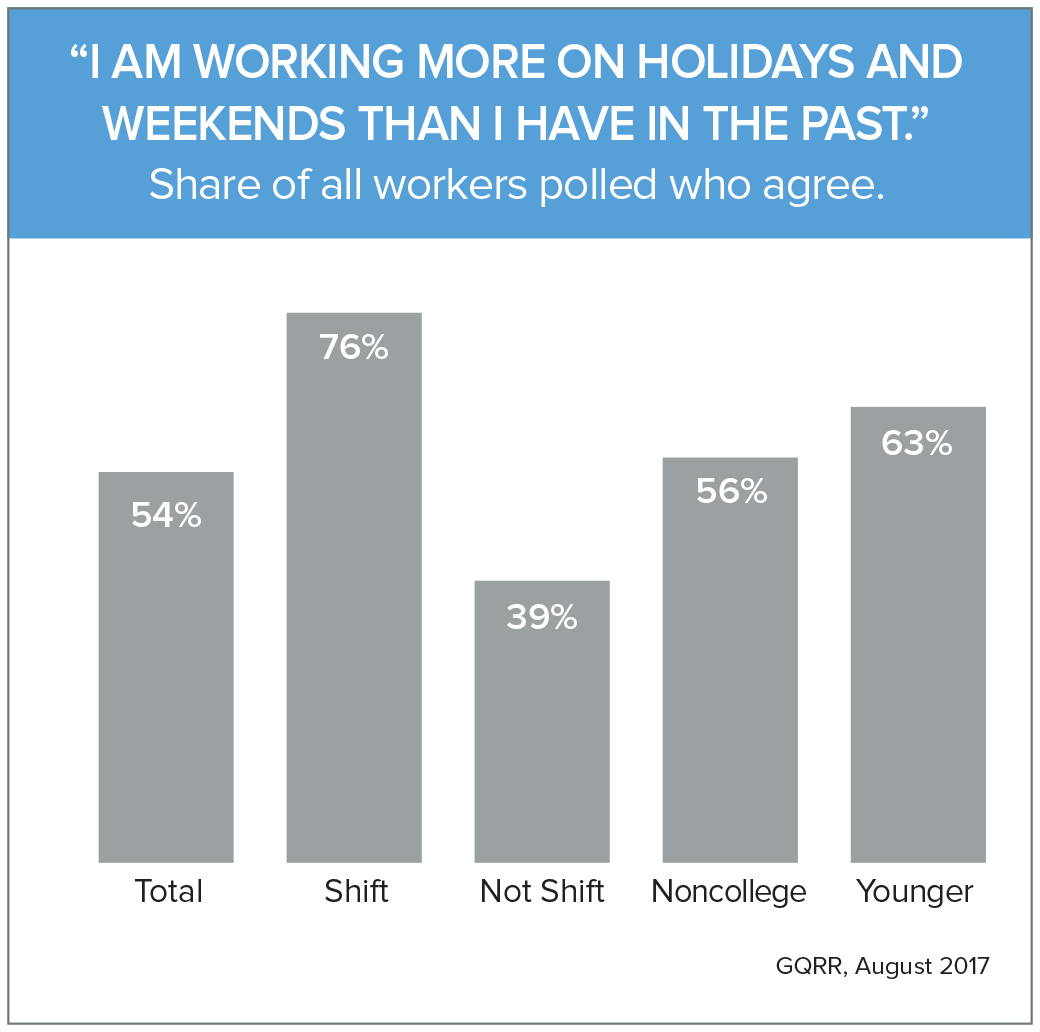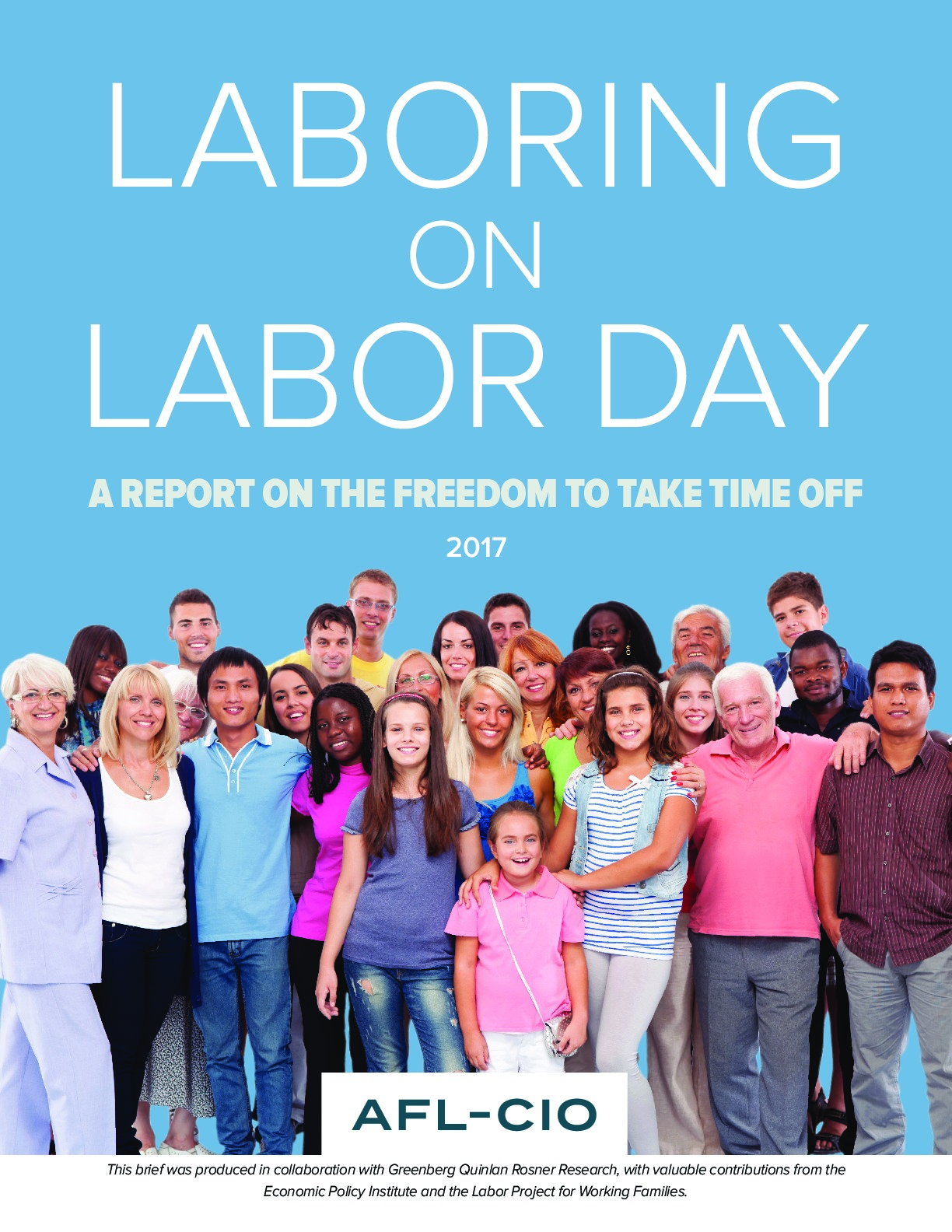Overview
Labor Day is an occasion to honor the achievements of working people. For many Americans it is also the last long weekend off before the end of summer. It’s a day to spend time with family and loved ones and an opportunity to gather before the new school year starts. But for too many of us, it is a reminder of how we are increasingly working more and harder for less.
This year, the AFL-CIO looked deeply into our work-life balance, a primary concern of America’s labor unions. We commissioned a national survey to examine whether working people have the freedom to enjoy paid holidays and time off. We wanted to know whether those benefits are negatively impacted by a culture that encourages us to work longer hours and to take work home on the weekend. We found a nation overcome by work, a truth felt most deeply by low-wage earners, who have hardly a moment to savor family, friends or relaxation.
Here’s what we knew even before the survey. According to the Economic Policy Institute, nearly a quarter of America’s private-sector workers—23%—have no paid time off for any holidays,1 including Labor Day, and 24% have no access to any paid vacation2 at all.
For those workers, a day home with children on a holiday must be balanced against a loss of pay. Lower-wage earners have less access to paid vacation. Among the bottom 10% of earners, 59% do not have access to paid holidays, while among the top 10% of earners, 7% do not have access to paid holidays3 and 8% do not have access to paid vacation.4

Our survey dives deeper into these numbers. We find that Americans are working more and taking fewer vacation days. While most people receive some sort of paid leave (vacation or sick), many are uncomfortable asking for time off. Majorities of young workers and shift workers agree they do not feel comfortable asking their employer for time off to care for a sick child or family member.

But there’s hope. Working people believe unions help protect their rights on the job and they want more freedom to form and join unions so they can advocate for better workplace benefits.
Here are the results.
The Union Advantage
In our Labor Day poll conducted by Greenberg Quinlan Rosner Research (GQRR), we found union membership is a key factor in whether a worker has paid time off.
Union members polled are much more likely to receive Labor Day off and overtime pay compared with their nonunion counterparts. While 78% of all working people polled have Labor Day off, 85% of union members do. Furthermore, 66% of union members receive overtime for working on Labor Day, compared with 38% of nonunion members. Seventy-nine percent (79%) of union members enjoy access to paid vacation, compared with 68% of nonunion members. Finally, 75% of union members have access to paid sick leave, compared with only 64% of nonunion members. It’s clear that by joining together in union, working people are able to create more time for family and more time to care for them.
Working Harder Than Ever for a Better Life
Americans are some of the hardest-working people in the world,5 yet our jobs alone do not define us. We go to work to make the rest of our lives possible. Work is supposed to buy the freedom to spend time with our families, pursue our dreams and come together to build strong communities. Unfortunately, that investment does not always pay off.
More than half (54%) of Americans surveyed work more holidays and weekends than ever and 43% percent bring work home at least one night a week. Although 78% of people polled report getting Labor Day off, about a quarter (26%) of them still will have to work in some form, either remotely or by going in to the jobsite. With less reported access to time off, women, younger workers and shift workers feel overworked the most.

The majority of Americans plan to spend Labor Day with families and friends. When asked about their plans, 18% said they would join a community event and 25% will attend a barbecue or party, though these responses are not mutually exclusive. Yet for many, Labor Day is also a time for the crucial unpaid care work our families rely on. Working people surveyed report plans to spend the holiday caring for children (12%), and running errands or doing household chores (13%).
The Gender Disparity
According to GQRR, most working people earn some form of paid time off and a majority think their employer would grant time to take care for a sick child or other family member. But women—often the primary caregivers in their households—are less likely than men (68% vs. 74%) to report access to paid time off and are less likely to expect overtime for working on Labor Day.
| "DO YOU GET OFF FROM WORK ON LABOR DAY?" | "ARE YOU PAID OVERTIME IF YOU WORK ON LABOR DAY?" | |||
|---|---|---|---|---|
| YES | NO | YES | NO | |
| Total | 78 | 22 | 46 | 54 |
| Women | 74 | 26 | 42 | 58 |
| Men | 82 | 18 | 50 | 50 |
| GQRR, August 2017 | ||||
Young and noncollege-educated women are especially vulnerable. Fifty-three percent (53%) of younger women and 53% of noncollege-educated women think their employers would give them time to care for a sick family member. Comparatively, 76% of younger men and 64% of noncollege-educated men expected the same of their employers.

Finding Time for Life Amid Work
According to Family Values at Work, only a paltry 14% of private-sector workers have access to paid family leave through their employers—time to take care of a family member’s long-term illness, recover from a medical condition or welcome a new child.6 As a result, about a quarter of women who are employed return to work within two weeks of giving birth to a child.7 Moreover, more than 37 million private-sector workers have no access to paid sick leave8 at all.
Paid family and medical leave and paid sick days are distinct policies, distinguished primarily by the length of time off and reasons, but both are fundamental to working people’s freedom to care for ourselves and our families.
For generations, working people have come together in unity to negotiate for the right to paid time off and holidays. Recent wins at the bargaining table have built on those successes, but all-out attacks from the corporate right wing and relentless attacks on workers’ security threatens those wins.
Unions Drive Progress
Over the past decade, 40 million9 working people have won the freedom to take time off through workplace victories and state and local policies guaranteeing paid sick leave or paid family and medical leave. Labor unions have been at the center of these wins. Recently, in New Jersey, New York and Washington, D.C., respectively, the AFL-CIO has played lead roles in the fights to expand access to paid sick leave and paid family and medical leave for all working people. Elsewhere, individual unions have been at the forefront of new and ongoing fights in Arizona, Maryland, Massachusetts, Oregon and Washington.
Working people understand that when we join together, we can protect our freedom to care for our families and ourselves.
GQRR found that 72% of Americans think unions help people enter the middle class and the same majority (72%) think unions are responsible for helping workers get Labor Day off and other paid holidays. Many are concerned that without unions, these benefits would not be guaranteed, and 43%, a plurality, think weaker unions could have a negative impact on whether workers receive adequate paid time off. So it should come as no surprise that a majority (54%) of working people would vote to join a union tomorrow if given the opportunity.

This Labor Day, the AFL-CIO will continue to push for an economy that supports work-life balance and ensures every worker has the freedom to spend time with loved ones. Whether it’s strengthening the right to form a union and negotiate for paid time off, expanding paid leave nationwide or rewarding employers that do the right thing, we are committed to advancing commonsense solutions that allow more Americans to enjoy full and happy lives.
ENDNOTES
1 Economic Policy Institute, Aug. 3, 2017, www.epi.org/chart/access-to-paid-holidays-share-of-private-sector-workers-with-paid-holidays-by-wage-group-2017/.
2 Economic Policy Institute, Aug. 3, 2017, www.epi.org/chart/access-to-paid-vacation-share-of-private-sector-workers-with-paid-vacation-by-wage-group-2017/.
3 Economic Policy Institute, Aug. 3, 2017, www.epi.org/chart/access-to-paid-holidays-share-of-private-sector-workers-with-paid-holidays-by-wage-group-2017/.
4 Economic Policy Institute, Aug. 3, 2017, www.epi.org/chart/access-to-paid-vacation-share-of-private-sector-workers-with-paid-vacation-by-wage-group-2017/.
5 https://data.oecd.org/emp/hours-worked.htm.
6 Family Values at Work, “The Impact of Our Wins,” http://familyvaluesatwork.org/docs/TheImpactofOurWins.pdf.
7 Ibid.
8 National Partnership for Women and Families, “Paid Sick Days: Busting Common Myths With Facts and Evidence,” July 2017, www.nationalpartnership.org/research-library/work-family/psd/busting-the-myths-about-paid-sick-days.pdf.
9 Family Values at Work, “The Impact of Our Wins,” http://familyvaluesatwork.org/docs/TheImpactofOurWins.pdf.



